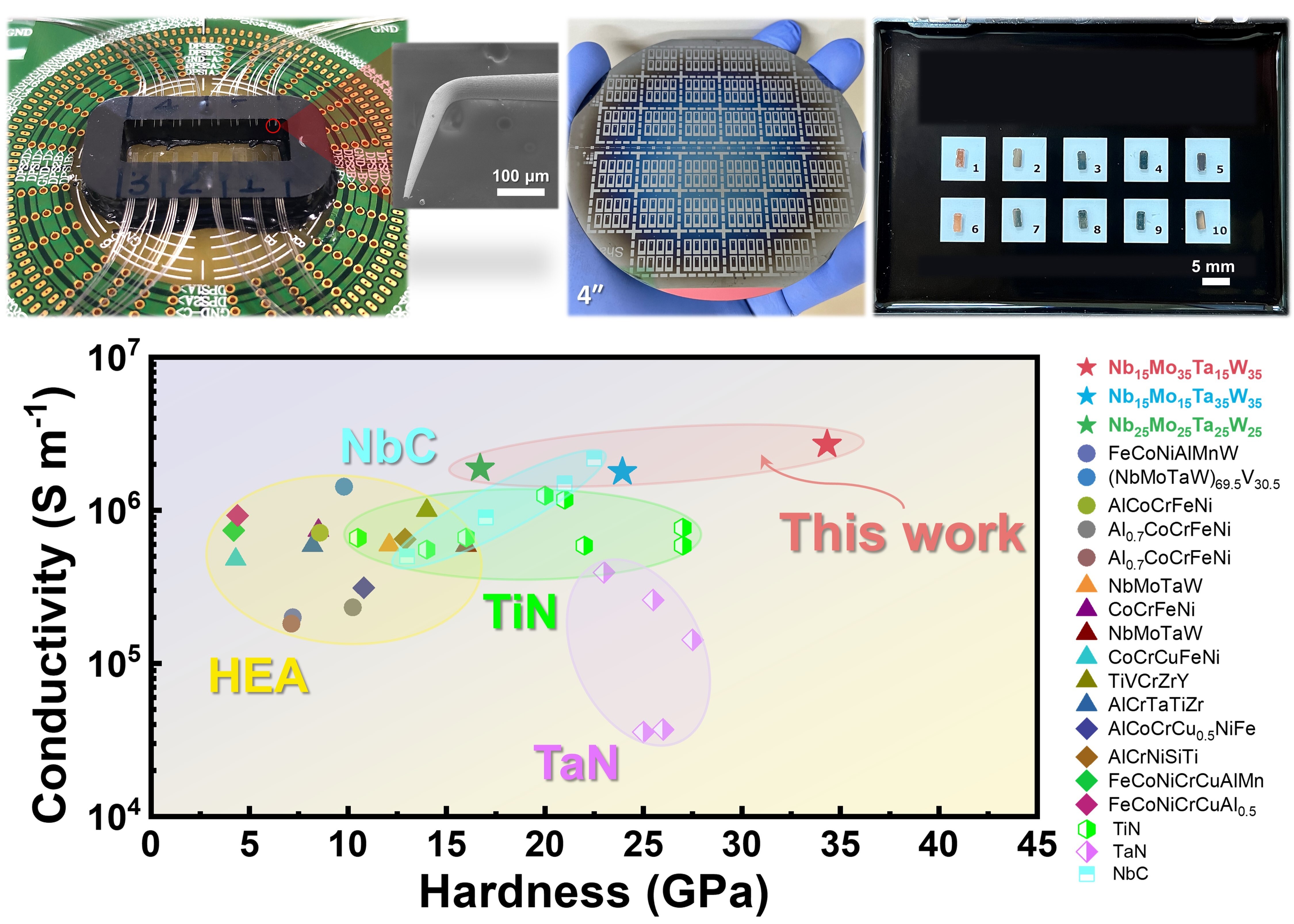An interdisciplinary team from National Cheng Kung University develops high-entropy materials with high electrical conductivity and low wear, published in a top international journal
Written & Image credit to Professor Chuan-Feng Shih research team.
High-entropy materials, comprised of multiple principal elements in near-equimolar ratios, have emerged as a leading field in materials science in recent years. The diverse combination of elements transcends traditional limitations, infusing new life into the periodic table and enabling innovative material applications. An interdisciplinary high-entropy team led by Professor Chuan-Feng Shih from the Department of Electrical Engineering at National Cheng Kung University (NCKU), along with Professors Bernard Haochih Liu and Wen-Dung Hsu from NCKU's Department of Materials Science and Engineering, Professor Chan-Shan Yang from National Taiwan Normal University's Institute and Undergraduate Program of Electro-Optical Engineering, and NCKU Ph.D. candidate Cheng-Hsien Yeh, has leveraged coating technologies, computational materials science, terahertz optoelectronics, and atomic-level surface techniques to address critical academic challenges in the field. Their research has led to the development of novel high-entropy materials that exhibit superior electrical conductivity and wear resistance. When applied as coatings on atomic force microscope probes, these materials enhance probe longevity and improve atomic-scale surface imaging during scans. This significant breakthrough has been published in the prestigious international journal "Nature Communications," attracting worldwide attention.
This research, grounded in the principles of optics, mechanics, electrical engineering, and computational materials science, proposes that high-entropy materials can be designed for electrical conductivity through the linear combination of elements. It demonstrates that electron transport behavior is related to effective electron mass, plasma frequency, and relaxation time, marking a significant discovery in the field of high-entropy materials. Building on this foundation, future design of high-entropy materials will be even broader. The paper is titled "Low-frequency conductivity of low-wear high-entropy alloys."
Professor Shih stated that this research represents a significant interdisciplinary collaboration and makes crucial contributions to the theoretical understanding of conductive mechanisms in high-entropy alloys. The findings have the potential to revolutionize industries such as semiconductors, connectors, communications, and passive components. Professor Hsu highlighted that while past research on high-entropy alloys has primarily focused on their mechanical properties, exploring their optical and electrical properties can significantly expand their applications in the semiconductor field, making it an exciting development for emerging materials. By employing computational simulations to develop predictive models for the optical and electrical properties of high-entropy alloys, the application of these materials in optoelectronic semiconductors can be expedited, facilitating their industrialization. Professor Liu emphasized that the research on high-entropy materials has progressed from theoretical exploration to industrial application. The utilization of high-conductivity, low-wear high-entropy materials in scanning probe measurement technology clearly demonstrates the advantages of these materials and opens up new possibilities for enhancing critical industrial technologies. Professor Yang noted that the novel electronic transport and optical properties of high-entropy materials will define their application domains. Developing appropriate measurement techniques and elucidating underlying mechanisms from fundamental physics will enhance the performance and design concepts of future optoelectronic semiconductor devices. The team expressed their gratitude for the continuous support from the National Science and Technology Council in Taiwan for the high-entropy project over the years.

The core members of the research team are Professor Chuan-Feng Shih from the Department of Electrical Engineering at National Cheng Kung University (NCKU) and Director of the Applied High Entropy Technology Center (second from the right), Professor Bernard Haochih Liu from the Department of Materials Science and Engineering at NCKU and Department Chair (first from the right), Professor Wen-Dung Hsu from the Department of Materials Science and Engineering at NCKU (center), Professor Chan-Shan Yang from the Institute and Undergraduate Program of Electro-Optical Engineering at National Taiwan Normal University (second from the left), and Ph.D. candidate Cheng-Hsien Yeh from the Department of Electrical Engineering at NCKU (first from the left).

The interdisciplinary research team led by Professor Shih from National Cheng Kung University has published a significant research paper in a prestigious sub-journal of the globally renowned "Nature" journal. The figure shows the first page of the paper.

This research establishes a conductive model for high-entropy alloy systems and designs alloy compositions with high conductivity and wear resistance. The alloy was applied as a coating on the ReW probe surface of semiconductor wafer test probe cards, resulting in over a 50% reduction in wear after 200,000 probe wear tests compared to commercial probes (top left). When applied as a coating on atomic force microscope probe surfaces, it reduced wear by 70-80% and improved atomic-level resolution compared to commercial probes (top right). The distribution map in the lower part shows that the Nb-Mo-Ta-W film proposed by Professor Shih's team possesses both high conductivity and high wear resistance, outperforming commonly used hard coatings in industrial applications and high-entropy alloy thin films reported in academic literature, demonstrating immense potential for industrial applications.

